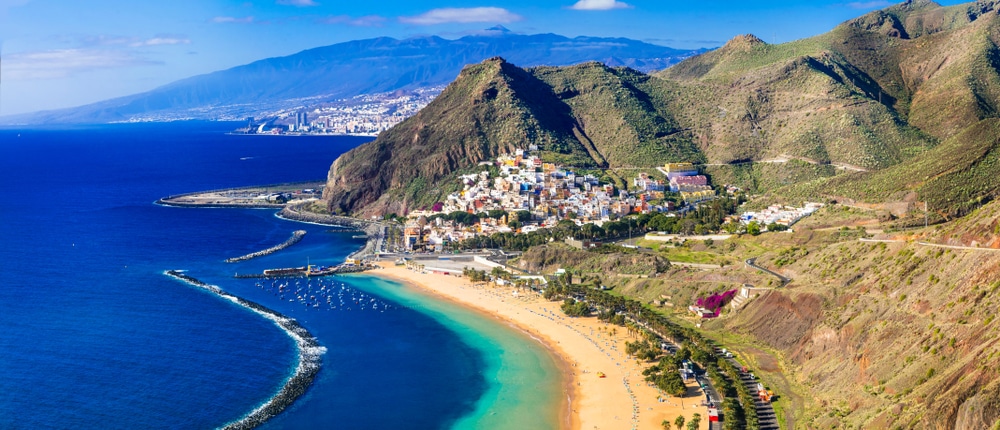No matter where you go on holiday on the largest Canary Island Tenerife , excursions to the capital Santa Cruz de Tenerife and the port city of Puerto de la Cruz should definitely be on the excursion program. Santa Cruz can be easily reached from most major resorts in the north.
The magical Santa Cruz
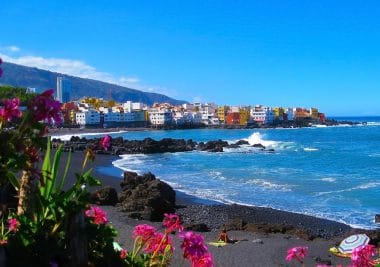
A stroll through the narrow streets of the old town is an absolute must. Sitting at the outdoor tables of the inviting bars, cafés and restaurants, watching the people strolling by and enjoying the sun – that’s pure holiday feeling! In the center of the oldest part of Santa Cruz is the church of Nuestra Señora de la Concepción with its tower visible from afar, and everywhere you can find picturesque buildings and remains from the colonial era.
If you like to go shopping, the best thing to do is to walk through the long pedestrian passage Calle Bethencourt Alfonso, which is also very attractive because of its large, shady trees. The typical Spanish market hall of Santa Cruz is popular with locals and tourists alike, because here you can not only buy fresh food, but also soak up the atmosphere with all your senses. A popular photo motif of the city is the auditorium at the harbor, which is reminiscent of the Sydney Opera House in its architecture. If you want, you can take a guided tour of the interiors. For plant lovers or holidaymakers who simply want to rest for a few minutes in a beautiful, green setting, we recommend the García Sañabria Park or the Botanical Garden.
The port city of Santa Cruz de Tenerife is probably one of the most beautiful places that the Canary Islands have to offer. With the historic city center, an impressive nightlife and a variety of cultural and gastronomic highlights, the city is a nice change from the rather quiet beaches of the island. Holidaymakers can not only look forward to a lot of sightseeing, great restaurants and a very special attitude to life, but of course also have the opportunity to travel to various other parts of the island and discover Tenerife.
One of the most beautiful cities in Spain on a beautiful island
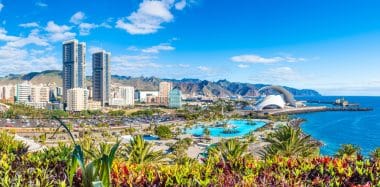
Along with Las Palmas de Gran Canaria , Santa Cruz de Tenerife is the capital of the Canary Islands region and has earned this title not only through the many destinations for tourists. After all, the city was founded in 1494 and was considered one of the first colonies that the Spaniards discovered during their mission to conquer the world. Since then, the Canary Islands have become an important intersection between the new and the old world, and the cultural influences that have flowed into the island from both sides have been correspondingly great, which can still be seen today.
The huge port, for example, is still a relic of the past and a focal point of life in the city. Above all, however, there are many historical buildings that have survived the centuries and give a small insight into the prosperity and importance of the Spanish colonial empire and what is left of it. This history is framed by a large number of green spaces that have been created in recent decades, making the city a bit of a small oasis. The contrast is a sight of its own, especially with the volcanic mountains in the background.
The main attractions in Santa Cruz de Tenerife
- In general, you should have seen the carnival in Santa Cruz de Tenerife. It is considered an absolute highlight and one of the most beautiful of its kind in Spain – but of course it is also an attraction for tourists, who flock to the city at this time to experience it. Apart from that, the port city has no shortage of sights for the rest of the year, for which you should definitely plan more than one day to experience them completely.
- Of course, you should have seen the old town if you decide to take a trip to Santa Cruz de Tenerife. This is where the first settlers of the island made their home and from here the city expanded in the decades that followed. With its squares, avenues and small alleys, the old town offers a lot of variety. In addition to the Plaza de España, which offers some of the best cafeterias in the city, you should also have been to the Plaza de la Iglesia. In particular, the monumental church of Nuestra Señora de la Concepción, which stands on the edge of the square, is considered one of the landmarks of the city and the entire island.
- If you want to let the mixture of cultures work its magic on you, you should pay a visit to the Mercado de Nuestra Señora de África. The market hall is not only an important supplier for the many great restaurants in the city, but of course also offers private visitors the opportunity to buy exotic goods and fresh products. There are also many small snack bars and restaurants that shop directly at the market and can therefore score points with fresh food.
Recreation and excursions in Santa Cruz de Tenerife
It wouldn’t be one of the most important cities in Tenerife if you didn’t find a lot of relaxation here easily and quickly. The palm gardens of the city itself invite you to linger and offer the opportunity to slow down a bit and thus let the city have a stronger effect on you. Above all, however, it is the many beaches in the area that attract visitors and promise a day of swimming. Playa de Las Teresitas is probably the most popular beach and can be easily reached by public transport or taxi. A trip with your own car is not worthwhile, because the situation with the parking spaces only offers pure chaos.
If you don’t want to go to the other sights of the island, you should pay special attention to the city’s nightlife. Santa Cruz turns into a terrific mix of bars and restaurants at night and, typical for the Spaniards, it is only after sunset that life begins for the locals. In the tapas bars and clubs you get to know a whole new side of Tenerife and can prepare for great new memories from your holiday.
The most popular holiday resort in the north of Tenerife: Puerto de la Cruz
The most important sights of the tourist centre can be easily conquered on foot, as most of the attractions are located on or at least near the seafront. One of the highlights is of course the complex of seawater swimming pools “Lago Martiánez”, designed by the Canarian artist César Manrique. Since high waves and strong surf often occur on the coast of the northern part of the island, the fantastic complex between the Atlantic Ocean and the beach promenade was built in the 1970s.
Since then, it has been possible to swim safely in its differently designed pools in an extraordinary ambience. World-famous and visitor magnet number 1 on Tenerife is the Loro Park. Over the decades, the park, which originally specialised only in parrots, has developed into one of the most beautiful zoos and amusement parks in Europe, which is also famous for its dolphin and orca shows and has already won several awards. A day at Loro Park is an essential part of a successful stay on the island, especially for families.
But tourists interested in culture will not miss out in Puerto de la Cruz either, because everywhere there are beautifully restored historic buildings to see, which date back to past centuries and remind us of the history of this former fishing village. A great example is the church of Nuestra Señora de la Peña de Francia, which dates back to the 17th century. Despite the rather inconspicuous façade made of dark lava rock, its interior hides a unique splendour. For example, part of the main altar is made of pure gold and the side altars are hardly less impressive. Puerto de la Cruz is truly a place that has something for everyone and exudes a wonderful holiday atmosphere.
Information about Puerto de la Cruz
Puerto de la Cruz is a town in the valley of La Orotava, in the north of the island of Tenerife. The name of the city comes from English and translates as “port of the cross”. Due to the volcanic relief of the island, the city center is located at an altitude of about 249 meters. Puerto de la Cruz is one of the best holiday resorts in the Canary Islands. The old town is very nice. Much of the area around the old fishing port consists of narrow, cobbled streets with colonial architecture. Today, Puerto de la Cruz has a wide range of beautiful hotels to suit all tastes and budgets. In addition to the old-world charm, the town also offers some of the most interesting attractions for visitors to the island.
Puerto de la Cruz in the past and today
Puerto de la Cruz was founded in 1502 as a small fishing village with a port that served the nearby large town of La Orotava. Gradually, the port gained importance until 1706, when the island’s volcano erupted and destroyed the main port of the north, Garachico, making Puerto de la Cruz the most important and busiest port on the island. Gradually, the sugar trade was replaced by wine production and exports. The exports initiated by the European colonizers after the conquest in the 15th century led to large flows of trade and passengers to the island for decades, and so the first foreign visitors to the island were attracted by the unique climate and air quality of the Taoro Valley, where they were treated for various respiratory diseases.
In the middle of the 17th century, the inhabitants of the settlement asked King Felipe IV for royal permission to secede from La Orotava and found their own city. Thus, Puerto de la Cruz was declared a city on May 3, 1651 and was able to elect its own rulers.
At the beginning of the 19th century, a large part of the European elite was drawn to the islands. Some of the most famous visitors were the writer William Wilde and the German explorer, geographer and botanist Alexander von Humboldt, who came to Tenerife to study the extraordinary flora.
Mass tourism began to play a crucial role in the local economy at the end of the 19th century. At that time, the first Taoro Hotel was built, and many of the old family houses from the colonial era were converted into hotels. One of the first tourist booms took place in the 1950s, when the city became a major tourist destination, not only on the island of Tenerife, but throughout the archipelago.
Best things to do in Puerto de la Cruz
If you are staying in Puerto de la Cruz, be sure to visit the artificial beach Lago Martianez. The road passes Punta del Viento (Windy Point), which is located above the Rustico restaurant, with rooms in the rock directly on the sea. From here you have a breathtaking view of the beach of Lago Martianez. This is probably one of the most photographed landscapes of Puerto de la Cruz. The coast of Puerto de la Cruz is very rocky and cannot be used as a beach by tourists. The famous architect of Lanzarote, César Manrique, designed Lago Martianez in such a way that it harmonizes with the natural features of the area.
The beach includes several islands in an artificial lake, gardens, restaurants, bars, terraces and all this fits into the natural profile of the sea coast and forms a great place for a beach or simply to relax. The palm trees and the volcanic rocks contribute to the exoticism of Lake Martianez. Unfortunately, you can’t freely enter the beach to walk there. Admission is subject to a fee. If you don’t want to pay that, you can explore almost everything outside of Lago Martianez. There is no barrier wall. The beach is one level lower than the promenade, and the difference in height between the two acts like a barrier.
On land, in addition to the beach, there are luxury hotels with spectacular views of Lake Martianez and the sea. The restaurants of the hotels and the restaurants in front of the hotels offer a varied menu, including seafood and the obligatory sangría. It’s not just about wine. In addition to red wine, Sangría also contains rum, at least two types of liqueur, the juice of fruit compote and its fruits, and fresh orange pieces. Cold sangria on balmy Tenerife nights is simply a divine drink – it cools the body and invigorates the senses.
In the streets of Puerto de la Cruz, Tenerife
If you stroll along San Telmo Street, which is located by the sea, you will notice that the alley smells of freshly baked waffles. At the other end, there are restaurants that are hard to walk past without stopping to see what they offer. You can eat the famous cold tomato soup called gazpacho andaluz.
The city center or the Plaza del charco (Puddle Square) traditionally divides the central part of the city into two parts. The eastern one (towards Lago Martianez) is more luxurious and has more shopping opportunities. The western part is quieter, more serene and has a more pronounced romantic character. There are many restaurants that are open for dinner, and all are small, with a few tables and a family atmosphere. They offer incredibly tasty dishes, and since there are few customers, the chef only cares about you. The result is unique.
Incomparable flair in San Cristobal de La Laguna
La Laguna, as the place is usually called, is the former capital of Tenerife and is located in the northeast of the island. It impresses with a historic old town from the 16th century, which is on the UNESCO World Heritage List. Tourists interested in history and architecture in particular will get their money’s worth here, as a large number of old churches and city villas characterize the picture. During a walk through La Laguna, which is located at an altitude of about 600 m, the oldest church on the island, the Nuestra Señora de la Concepción, should definitely be on the program. The Museum of History and Anthropology, which is largely dedicated to the indigenous people, the Guanches, is also recommended not only for bad weather days.
San Christobal de La Laguna – the cool beauty among Tenerife’s cities
Nestled in the high valley of Aguere lies San Christobal de La Laguna. No other city in the Canary archipelago can boast as many churches, chapels, monasteries and hermitages as San Christobal de La Laguna. What are you waiting for? Tangible, tangible history invites you to take a walk into the past.
Founded in 1496 near a small lake that has now disappeared, San Christobal de La Laguna was not only the capital of Tenerife, but of the entire archipelago. As a residential and administrative city, La Laguna attracted intellectual and spiritual life. The military had its headquarters here, as did the bishop and various monastic orders, which enriched the cityscape with handsome churches and monasteries.
Today, the city with over 150,000 inhabitants is the seat of the most important university in the Canary Islands, among other things.
On the shortest route to La Laguna: A tram connects the new island metropolis of Santa Cruz with the old capital San Christobal de La Laguna. In 1833, Santa Cruz replaced La Laguna as the island’s capital. To this day, San Christobal de La Laguna presents itself like an open history book. More than 40 historic buildings in the old town are designated as UNESCO World Heritage Sites. As soon as the Guanches were subdued, the Spanish conquistadors began to build a colonial city, which was to be groundbreaking for the founding of cities in the New World.
The UNESCO-ennobled colonial splendor is best discovered in a morning – ideally on a Thursday or Saturday, when all the museums and monasteries are open. Tip for a first impression: From the tower of the Concépsion Church you have a great view over the World Heritage City.
Let’s move on! San Christobal de La Laguna inspires with colorful student hustle and bustle and a charming old town. Churches, monasteries, museums, restaurants and wine bars – La Laguna surprises with an extraordinary diversity. Most of the central streets are traffic-calmed, the facades painted pastel and the romantic courtyards restored. The Plaza de Cristo with the adjoining Parque de la Constitucion in the east of the city is an atmospheric prelude to a city tour.
Others start their tour at the Plaza del Adelantado. The crowns of the palm trees, laurel and dragon trees form such a dense roof over the square that hardly a ray of light penetrates the ground. The square, named after the “adelantado”, the “leader”, is flanked on all sides by monasteries and stately residences.
Stroll zone with flair
A stroll through Calle Heradores, recently converted into a pedestrian mile, introduces you to the carefully restored heritage of the old capital. Many pretty details can be discovered: tiny wrought-iron standing balconies, massive brass door knockers or the coat of arms of a family clan above the lintel. In some places, a fountain splashes in green courtyards, such as in the almost 400-year-old Casa Alvarado Bracamonte, from which the captains general once steered the fate of the island with an iron hand.
One of the oldest buildings is the house of the bailiff near the central Plaza del Adelantado. On the square with an old dragon tree, the classicist town hall and the St. Catherine’s monastery, adorned with a Moorish-looking balcony, are among the most striking buildings.
A visit to the Casa de Lercaro, which is furnished with magnificent woodwork, rounds off the journey through time, fittingly housed the Museum of the Island’s History.
Despite history on every corner, La Laguna is a young city. This is mainly due to the university, which was founded in 1792 and today has around 24,000 students.
Short break
The tapas bars at the Plaza de la Conepción are very popular, where Café Palmelita also invites you to coffee and cake. The square in front of the church with its pretty street cafés is an ideal place to let the historical flair work its magic on you in a deeply relaxed way.
Hiking paradise and beach fun – the surroundings are wonderful
The way can hardly be long enough for lovers: Not only couples enjoy a walk along the palm-lined Avenida Paseo de las Palmas.
But La Laguna is also a hiker’s paradise: From the city, a road winds up to the Bosque de la Mercedes in the Anaga Mountains. However, the peninsula in the far northeast only shows itself in the best light to early risers. Around noon at the latest, milky wafts of mist usually envelop the mountains in a dense cotton pack. On a clear day, the Pico del Inglés viewpoint, which is almost 1,000 metres above sea level, offers a great view of the Anaga Mountains.
A hike to the cave dwellings in Chinamada, lined with geraniums, which unfold a beguiling colourfulness under a bright blue sky, is also popular. Meanwhile, Playa de las Teresitas near San Andrés satisfies the longing for sun and sea.
From fishing village to tourist hotspot – Los Gigantes
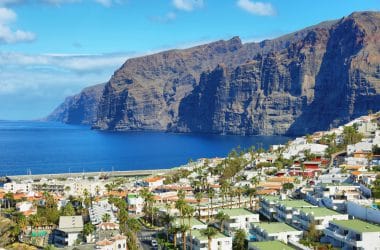
Nature lovers and active holidaymakers in particular will be delighted by a stay in Acantilados de Los Gigantes (Rock Face of the Giants) in the west of Tenerife. The district of the municipality of Santiago del Teide has become a popular destination due to its fantastic coastal landscape. The vertical rock walls extend over a length of more than nine kilometres, reaching a height of up to 500 m and are therefore considered the second highest in Europe. Various viewpoints each offer fantastic views, but on one of the boat tours on offer you can experience the cliffs from an even more impressive perspective. Trips to observe dolphins and pilot whales also start here. The underwater world is a paradise for divers and snorkelers and bathing tourists love the nearby Playa de los Guios, which scores with its black volcanic sand. Los Gigantes offers more than 300 days of sunshine a year and a decidedly mild climate – a perfect starting point for hikes in the Teide National Park and through the Teno Mountains.
Costa Adeje – ideal for a comfortable beach holiday
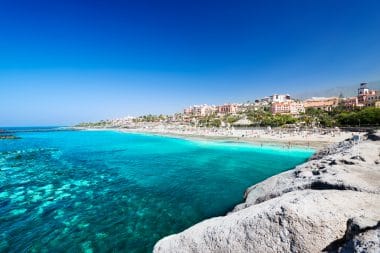
Costa Adeje is located in the southwest of Tenerife and is ideal for tourists who want to spend a classic beach holiday and value a first-class infrastructure. On the well-kept beach promenade you will find fine restaurants as well as tasteful shops and the surrounding area offers some of the most beautiful beaches on the island.
The Costa Adeje is a comparatively little-discovered section of the popular island of the Canary Islands. The city of the same name for the region is almost a bit sleepy compared to the big tourist strongholds, which offers a charm of its own for travelers who get lost in this direction. Costa Adeje has just as many sights to offer, especially with regard to nature, as many other parts of the island. In addition to its own sights, the way to the rest of the island is of course still free, which can be easily reached from here, especially with your own car.
Luxury and special enclaves – the retreat in Tenerife
Over the years, Costa Adeje has gained a reputation for being particularly exclusive and offering a special luxury in both shops and hotels. Here, the focus is on particularly high-quality but also expensive accommodation, and in the city’s shops, high-quality brands are not uncommon for holidaymakers. It is also important to know that the name does not only refer to the small town, but to the entire section of the coast in this area of the island. This leads to confusion from time to time.
The distinction between town and coast is important because the region was created only a few decades ago and does not have a historical heritage, as is the case with Santa Cruz de Tenerife, for example. Instead, you have to deal with an interesting tourist infrastructure that is a bit more designed for rest and relaxation than for sightseeing and adventure. Especially those who are looking for a few quiet days and weeks will get their money’s worth in Costa Adeje – which is also due to the many good accommodations.
If you are looking for historical sites in Tenerife, you will find them especially in the city of Adeje, the namesake of the region. Unlike the tourist resorts, the focus here is mainly on the preservation of the various historical buildings and offers hikers, cyclists and accompanied tours an interesting insight into the history of the island.
The main attractions when visiting Costa Adeje
- A trip to historic Adeje should definitely be done when visiting the region. Whether it’s historical places like the church of Santa Úrsula or the various historic housing complexes, here you can get a good view of how the first settlers lived on the island and what architecture they used. Most hotels in the holiday region offer corresponding tours, but you will also get to the village quite quickly and easily by bike or rental car.
- Of course, you have the opportunity to see the many other sights of the island. However, since Costa Adeje is a fairly new area, there are no classic historical sights here. Instead, the focus has been on a comprehensive range of leisure and relaxation activities and offers a wide variety of options in this area. Therefore, a trip to Santa Cruz de Tenerife, which can be reached in a few hours, can satisfy the hunger for historical sights. In general, a trip to the city is recommended from any point in Tenerife, because the city has a very special magic.
Tranquillity, recreation, food and nightlife in Costa Adeje
Those who decide to spend their holidays on the Costa Adeje want above all to enjoy life and the island itself. So it’s no wonder that the region has adapted to these holidaymakers in particular. Restaurants, cafes and bars can be found everywhere and there are also snack bars and the right places for snacks on the many beaches. Water sports play a role and the beaches offer not only sun and sand, but also a wide variety of activities for the long day. The hotels, for example, have interesting offers in the field of massages and treatments at the spas and are therefore interesting alternatives for a long day at the sea.
In the evening, the trip to Costa Adeje is all the more worthwhile. The nightlife here has developed in a very short time and offers not only clubs and bars, but also theatres and events that are interesting and can give a special touch to the holiday


